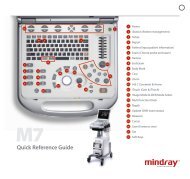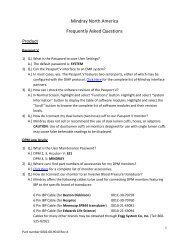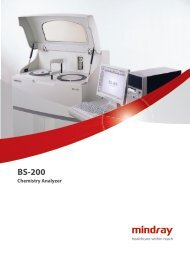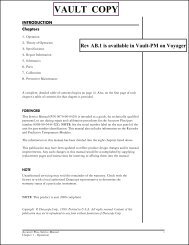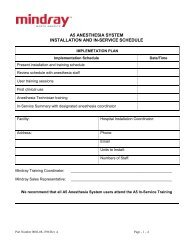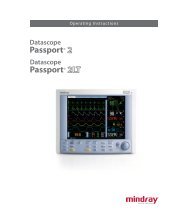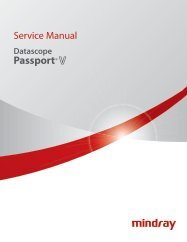Passport® - Mindray
Passport® - Mindray
Passport® - Mindray
- TAGS
- mindray
- res.mindray.com
Create successful ePaper yourself
Turn your PDF publications into a flip-book with our unique Google optimized e-Paper software.
NIBP Monitoring NIBP Measurements<br />
7.4.11 Recommendations for Automatic Blood Pressure Measurements<br />
7.4.12 Cuff Size<br />
The following practices are recommended when making automatically cycled blood pressure<br />
measurements:<br />
Position and support the limb in such a way as to minimize stretching of and weight<br />
exertion on affected nerves<br />
Avoid cuff placement that applies pressure on the ulnar nerve. Cuff tubing should not<br />
exit the cuff over the course of the ulnar nerve at the elbow<br />
Select a measurement interval that provides adequate venous drainage during cuff<br />
deflation<br />
Periodically inspect the limb bearing the cuff in order to detect venostasis<br />
If necessary move cuff to another limb to relieve single-limb stress<br />
Using a narrow cuff gives erroneously high pressure readings. If a standard cuff is applied to<br />
an obese patient or a patient with large biceps, the extra tissue and fat will dissipate the<br />
applied pressure requiring an additional pressure increase to collapse the artery. On the<br />
other hand, over-wrapping a slender arm gives erroneously low pressure readings because<br />
too much force per unit area is exerted. This requires less pressure to collapse the artery.<br />
7.4.13 Other Factors<br />
An accurate determination of blood pressure by the Passport V can be difficult if cardiac<br />
rhythm is irregular. Irregular cardiac rhythm changes the stroke volume from beat to beat.<br />
This changing stroke volume may increase the time it takes the Passport V to take a<br />
measurement. The Passport V makes up to four successive attempts to obtain a<br />
measurement. If a measurement cannot be taken after four tries, the numeric displays are<br />
zeroed.<br />
7.4.14 User Verification of Passport V Blood Pressure Measurements<br />
Regular service to blood pressure equipment will help ensure accurate measurements.<br />
Consult your Service Manual for appropriate information. If you question the accuracy of the<br />
Passport V, verify the blood pressure with a manometer.<br />
Auscultatory verification can be made at the same time the Passport V is taking a<br />
measurement. Apply a bell stethoscope over the brachial artery. Do not allow the<br />
stethoscope to touch either the patient’s clothing or the pressure cuff.<br />
7.4.15 Newborn NIBP Technique<br />
Newborn patients present unique obstacles to NIBP measurement. Their vital signs can<br />
change from moment to moment, and their tiny physiological signals are very prone to noise<br />
interference. The following suggestions will help you to obtain the best possible NIBP<br />
measurement:<br />
1. Try to measure infants when they are calm. A kicking/crying baby may disturb or jiggle<br />
the cuff, causing noise within the system and resulting in unstable blood pressure<br />
readings. If necessary, hold the cuffed limb steady, without impeding circulation. Do not<br />
hold onto the cuff and do not pat the cuffed limb to comfort the child.<br />
Passport V Operating Instructions 0070-10-0704-02 7 - 11



